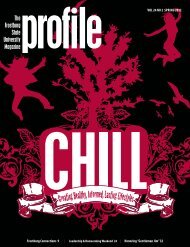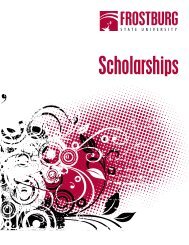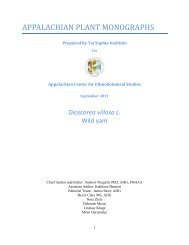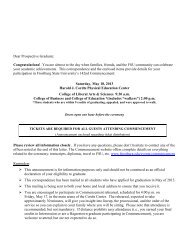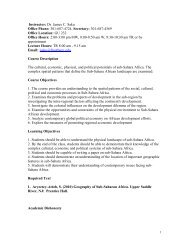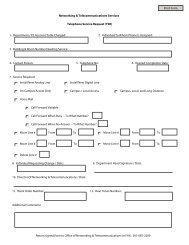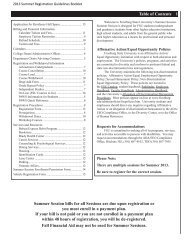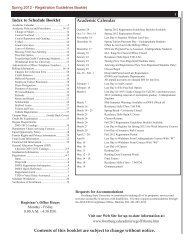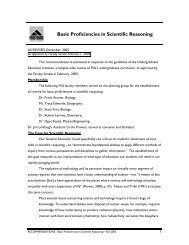Boneset – Eupatorium perfoliatum L - Frostburg State University
Boneset – Eupatorium perfoliatum L - Frostburg State University
Boneset – Eupatorium perfoliatum L - Frostburg State University
Create successful ePaper yourself
Turn your PDF publications into a flip-book with our unique Google optimized e-Paper software.
APPALACHIAN PLANT MONOGRAPHS<br />
Prepared by Tai Sophia Institute<br />
For<br />
Appalachian Center for Ethnobotanical Studies<br />
September 2011<br />
<strong>Eupatorium</strong> <strong>perfoliatum</strong> L.<br />
<strong>Boneset</strong><br />
Chief Author and Editor: Andrew Pengelly PhD, AHG, FNHAA<br />
Assistant Author: Kathleen Bennett<br />
Editorial Team: James Snow AHG<br />
Bevin Clare MS, AHG<br />
Nora Zietz<br />
Deborah Mizur<br />
Lindsay Kluge<br />
Mimi Hernandez<br />
1
<strong>Boneset</strong> <strong>–</strong> <strong>Eupatorium</strong> <strong>perfoliatum</strong> L.<br />
1. Taxonomy<br />
<strong>Eupatorium</strong> <strong>perfoliatum</strong> L.<br />
Family: Asteraceae<br />
Common names: boneset, ague-weed, crossword, feverwort, Indian sage, sweating weed,<br />
thoroughwort, wild Isaac, tea-gel, vegetable antimony.<br />
Synonyms: There are no commonly accepted synonyms for E. <strong>perfoliatum</strong>.<br />
2. Botanical description and distribution<br />
E. <strong>perfoliatum</strong> is an upright perennial growing to about four feet, with a stout stem<br />
covered with long spreading hairs and branching at the summit. Leaves are opposite,<br />
sessile and lanceolate in shape with acuminate tip, the opposite leaf pairs adjoining at<br />
their bases and encircling the stem node („perfoliate‟). Flowers are born in capitula of 9-<br />
23 white tubular florets arranged in terminal corymbs, the florets maturing to produce<br />
dry, angular achenes (Gleason & Cronquist, 1991). E. <strong>perfoliatum</strong> is found in swamps<br />
and damp areas, alluvial woods and pastures throughout the Appalachian region<br />
(Krochmal, Walters & Doughty, 1969).<br />
2<br />
Figure 1. Image from<br />
A Textbook of Botany<br />
and Pharmacognosy<br />
by Henry Kraemer<br />
1907. J.B. Lippencott,<br />
Philadelphia.
Part Used<br />
Dried flowering herb harvested in summer.<br />
3. Traditional uses<br />
Traditional uses in Appalachia<br />
E. <strong>perfoliatum</strong> was among the many indigenous plants that Appalachian settlers learned<br />
to use from the local Native Americans (Crellin & Philpott, 1989). By the 1800s, it had<br />
become a favorite household herb and was used for a variety of conditions such as fevers,<br />
colds, coughs, headaches, and rheumatism (Howell, 2006). A tea was also used for<br />
consumption and as a laxative (Krochmal, Walters and Doughty, 1969). E. <strong>perfoliatum</strong><br />
remains a common remedy for promoting digestion and tonifying the gastrointestinal<br />
system. In small doses it is said to soothe the tissues while larger doses promote an<br />
emetic response useful in fevers and chronic illness. The whole plant is administered as a<br />
strengthening tonic in low grade fevers, and as a hot infusion it is known to promote<br />
diaphoresis. It has been particularly useful to the people of Southern Appalachia for<br />
“sweating a cold out of the body” (Cavender, 2003, p. 84). No other herb seemed to rival<br />
its effectiveness in dealing with fevers, with few or no ill side effects (Erichsen, 1979).<br />
Traditional uses outside Appalachia<br />
Native American<br />
Most common uses of E. <strong>perfoliatum</strong> were for treatment of fevers and as a<br />
gastrointestinal aid for pains in the stomach. The entire plant was used, with an infusion<br />
of the leaves (and sometimes the whole plant) applied topically for headaches and fevers,<br />
and as a poultice on broken bones. An infusion of leaves and flowers was taken for a<br />
laxative effect. The smashed roots were said to cure typhoid conditions. Infusions of the<br />
leaves were also employed for early stages of colds and fevers, kidney troubles, and for<br />
“general debility” (Moerman, 1998). The Mesquakies used the root for snakebite and the<br />
aerial parts for expulsion of worms (Kindscher, 1992).<br />
Folklore & Home<br />
A preparation of E. <strong>perfoliatum</strong> in any form (tea infusion or decoction or powder) was<br />
used with “uniform success” in the treatment of intermittent fevers, in particular yellow<br />
fever. It was also a popular home remedy for dyspepsia when drunk as a cold tea<br />
throughout the day, while in the form of a warm infusion it acted as an emetic <strong>–</strong> it was<br />
dose dependent in its response (Beach, 1851). Often, it was preferred in place of<br />
chamomile as a tonic stimulant (Child, 1837). As a general tonic, it was employed with<br />
aromatics in tinctures or powders (Gardner & Aylworth, 1836). An infusion was said to<br />
be diaphoretic and was commonly drunk at the onset of fevers to promote sweating<br />
(Child, 1837).<br />
Physiomedical<br />
E. <strong>perfoliatum</strong> was a popular remedy for physiomedicalists also, and its effects were<br />
often dose and preparation dependent. Given as a cold infusion, it was a decidedly<br />
relaxing tonic acting primary on the liver and gall bladder while also acting as a mild<br />
3
laxative. It was said to target sensitive or tense tissues, providing a relaxing, calming<br />
effect on the smooth muscle. It was commonly combined with other herbs to promote a<br />
strengthening response for general debility, and also for weak tissue states. Prepared as a<br />
warm infusion, it was an excellent remedy for yellow fever as a diaphoretic. It was used<br />
to provide relief from “aching limbs” secondary to rheumatism and, in larger quantities,<br />
to promote emesis (Cook, 1869). Clymer later confirmed this approach, using the cold<br />
infusion and tincture as a tonic, warm infusion as a diaphoretic and larger doses as an<br />
emetic <strong>–</strong> however he believed it to be inferior to Lobelia inflata L. in that respect<br />
(Clymer, 1905).<br />
Eclectic<br />
Scudder (1898) found E. <strong>perfoliatum</strong> to be a useful remedy for the onset of colds and<br />
fevers, where the body becomes stiff and achy. The relaxing effect proved most useful in<br />
joint, muscle and skeletal pain, as well as promoting secretions to eliminate lingering<br />
illness. It was used by nearly every Eclectic physician in the treatment of fevers and flu<br />
and for the common cold “especially when accompanied by deep-seated, aching pain”.<br />
For respiratory conditions, Felter (1922) considered it, “efficient to relieve cough, acting<br />
best in that occurring in the aged and debilitated, where there is an abundance of<br />
secretion, but lack of power to expel it”.<br />
The most well documented use of E. <strong>perfoliatum</strong> by Eclectic physicians was during the<br />
1918-19 influenza epidemic, highlighted by two practitioner reports of over 1,000 treated<br />
cases with only five fatalities (Brinker, 2009). The two popular preparations in use at the<br />
time were the warm infusion and Lloyd‟s Specific <strong>Eupatorium</strong> extract (Brinker, 2009).<br />
Regulars<br />
Following observations of Native Americans, allopathic physicians used E. <strong>perfoliatum</strong><br />
for febrile conditions such as influenza, typhoid and yellow fever - especially when the<br />
pains were at their worst. In the early 1800s Dr. Brigalow of Harvard <strong>University</strong> applied<br />
it to cutaneous conditions as well as for intermittent fevers, while William Barton MD<br />
praised its use in typhus and N. Chapman MD recommended it for respiratory catarrh and<br />
as a hot infusion for the “breakbone fever‟ form of influenza, leading to the use of the<br />
common name - boneset (Brinker, 2009). Other physicians used it for dyspepsia and<br />
general debility (Wood & Bache, 1858). It was official in the United <strong>State</strong>s<br />
Pharmacopeia (USP) between 1820 and 1900.<br />
4. Scientific research<br />
Phytochemistry<br />
Sesquiterpene lactones<br />
Sesquiterpene lactones (STLs) are signature compounds of the large <strong>Eupatorium</strong> genus<br />
and of the Asteraceae family in general. In E. <strong>perfoliatum</strong> the STLs are represented by<br />
two structural classes, the guaianolides and the germacrolanolides (Herz, Kalyanaraman,<br />
& Ramakrishnan, 1977). Recently Mass et al. (2011) described several new STLs using a<br />
high performance liquid chromatography (HPLC) coupled with mass spectrometry<br />
(MSMS) method. There were four new guaianolides - one dimeric guaianolide and one<br />
4
germacroanolides - and all showed antiprotozoal activity against the malaria vector<br />
Plasmodium falciparum and other protozoa (Maas,Hensel, da Costa, Brun, Keiser &<br />
Schmidt, 2011).<br />
Table 1. Classification of named sesquiterpene lactones in E. <strong>perfoliatum</strong><br />
Guaianolides Germacrolanolides<br />
Euperfolide Euperfolitin<br />
11,13 <strong>–</strong> dihydroeuperfolide Euperfolin<br />
Eufolitin<br />
Eufoliatorin (a dilactone)<br />
(Herz, Kalyanaraman, & Ramakrishnan, 1977; Maas et al., 2011)<br />
Polysaccharides<br />
Two polysaccharides have been isolated from E. <strong>perfoliatum</strong> by HPLC coupled with<br />
nuclear magnetic resonance ( 13 C NMR) spectroscopy methods (Vollmar, Schäfer, &<br />
Wagner, 1986). The two compounds were characterized as 4-0-methylglucuronoxylans,<br />
one of high molecular weight (>500,000) and a smaller one (ca 40,000), and both showed<br />
phagocytocis-enhancing activity (Vollmar, Schäfer, & Wagner, 1986).<br />
Flavonoids<br />
Methoxyflavonoids are another characteristic compound group among the <strong>Eupatorium</strong><br />
genus. Herz et al. (1972) isolated three dihydroxyflavonols from E. <strong>perfoliatum</strong> in the<br />
early 1970s, while Wagner et al. identified astragalin, hyperoside, quercetin and<br />
kaempferol (Maas, Petereit, & Hensel, , 2009). More recently four methoxylated<br />
flavonoid aglycones - eupafolin, hispidulin, patuletin and kaempferol - were identified<br />
using HPLC coupled with 1 H and 13 C NMR and mass spectroscopy (MS) (Maas et al.<br />
2011) as well as glycosides of quercetin and kaempferol (Maas et al. 2009).<br />
Phenolics<br />
Using reverse phase HPLC coupled with diode array (DAD-UV), six caffeic acid<br />
derivatives were isolated and identified by NMR spectroscopy. They were quinic acid,<br />
chlorogenic acid, neochlorogenic acid and three depsides of caffeic acid (Maas et al.<br />
2009). A chromatogram showing eight caffeic acid derivatives and four flavonoids is<br />
presented in appendix 1.<br />
5
Figure 2. Structure of caffeic acid derivatives in E. <strong>perfoliatum</strong>. Reproduced from Maas<br />
et al. 2009<br />
Other constituents<br />
Other less well characterized constituents of E. <strong>perfoliatum</strong> are chromenes and the<br />
triterpene alpha-amyrin, sterols, diterpenes dendroindinic acid and hebenolide,<br />
dotriacontane <strong>–</strong> a hydroharbon, and volatile oils (Skenderi, 2003; Brinker 2009; Natural<br />
Standard, 2011).<br />
Pharmacology<br />
General<br />
Sesquiterpene lactones from E. <strong>perfoliatum</strong> have been shown to have cytotoxic and<br />
immune-stimulating actions in vitro (Herz, Kalyanaraman, & Ramakrishnan, 1977;<br />
Wagner, Proksch, Vollmar, Kreutzkamp, & Bauer, 1985) while an ethanolic extract of<br />
the dried leaves showed stong cytotoxic effects against three mammalian cell lines and<br />
weak antibacterial effects against two gram-positive species (Habtemariam &<br />
Macpherson, 2000). Aqueous extracts and isolated polysaccharides have also shown<br />
immune modulating effects - by significant enhancement of phagocytosis in vitro and in<br />
vivo (Wagner et al., 1985; Vollmar, Schäfer, & Wagner, 1986). Studies conducted in the<br />
early 1900s demonstrated antibacterial activity against Staphyloccus aureus in vitro<br />
(Brinker, 2009)<br />
Antimalarial effects<br />
E. <strong>perfoliatum</strong> has long had a reputation for treating febrile disorders, and was widely<br />
used by Indians for this purpose (Hall, 1974; Brinker, 2009). Studies with STLs indicate<br />
many of these compounds have potent effects against protozoans, though the effects may<br />
be linked to their inherent cytotoxicity (Schmidt, Nour, Khalid, Kaiser, & Brun, 2009).<br />
Chloroform extract of E. <strong>perfoliatum</strong> aerial parts actively inhibited the malarial vector<br />
Pasmodium falciparum in vitro, and a dimeric guaianolide STL was shown to be the most<br />
active constituent (Maas et al., 2011). The cytotoxicty of this compound was relatively<br />
weak. Using a rodent malaria, Lira-Salazar and co-workers found that homeopathic<br />
potencies of E. <strong>perfoliatum</strong> tincture demonstrated significant <strong>–</strong> though not completely<br />
inhibitory <strong>–</strong> effects against Plasmodium berghei, which were stable over several days<br />
(Lira-Salazar, Marines-Montiel, Torres-Monzón, Hernández-Hernández, & Salas-Benito,<br />
2006).<br />
6
Clinical trials<br />
No published clinical trials were found in the literature review.<br />
5. Modern Phytotherapy<br />
Modern therapeutic use of E. <strong>perfoliatum</strong> reflects traditional indications. The German<br />
herbal physician Rudolf Weiss (1988) lists boneset alongside other tonics such as<br />
Echinacea spp. for treating acute viral infections and enhancing overall immunological<br />
resistance. Modern herbal practitioners continue to value the therapeutic benefits of fever,<br />
and boneset‟s diaphoretic effect is seen as playing a key role in the treatment of the<br />
common cold and influenza (Mills & Bone, 2000). Kuts-Cheraux (1953) suggests that<br />
boneset‟s positive influence on body aches associated with infections can be extended<br />
more broadly to treatment of rheumatic pains in general. A classic indication is fevers<br />
with “dry skin, not followed by perspiration, with deep seated aching pain and great<br />
thirst” (Harper-Shove, 1952).<br />
Table 2: Modern phytotherapeutic uses of E. <strong>perfoliatum</strong><br />
ACTIONS<br />
Diaphoretic emetic (high doses)<br />
Expectorant immune-stimulant<br />
Aperient Bitter<br />
THERAPEUTIC INDICATIONS<br />
Early stages of colds and influenza<br />
Nasopharyngeal catarrh<br />
Acute bronchitis<br />
Fever accompanied by aching bones and muscles<br />
Rheumatoid and gouty arthritis<br />
(Priest & Priest, 1982; British Herbal Medicine Association, 1983; Mills & Bone, 2000)<br />
Specific indication<br />
Influenza with deep aching, and congestion of the respiratory mucosa (British Herbal<br />
Medicine Association, 1983)<br />
Combinations<br />
With Sambucus nigra L. and Salix spp. for prostrating fevers with aching in the bones.<br />
With Scutellaria lateriflora L. and Asclepias tuberosa L. for influenza (Clymer, 1905).<br />
Preparations and dosage<br />
Dried herb 1-2g three times daily or by infusion.<br />
FE 1:1, 1-2 mL, 3 times daily (British Herbal Medicine Association, 1983).<br />
7
Toxicity and contraindications<br />
The Botanical Safety Handbook classifies E. <strong>perfoliatum</strong> as Class 4 <strong>–</strong> “Herbs for which<br />
insufficient data is available for classification,” because of the possibility of other<br />
potentially toxic <strong>Eupatorium</strong> species being substituted (McGuffin, Hobbs, Upton, &<br />
Goldberg, 1997). While toxic pyrrolizidine alkaloids have been identified in some<br />
<strong>Eupatorium</strong> species (Smith & Culvenor, 1981), none have ever been identified in E.<br />
<strong>perfoliatum</strong> (Skenderi, 2003; Maas & Hensel, 2008). This herb has a long history of<br />
documented usage and few side effects have been reported, although large doses are<br />
emetic and purgative. E. <strong>perfoliatum</strong> may cause contact allergic dermatitis in persons<br />
hypersensitive to Asteraceae plants containing sesquiterpene lactones (Skenderi, 2003). It<br />
should be avoided during pregnancy and lactation.<br />
E. <strong>perfoliatum</strong> does not contain the toxic alcohol tremetol, found in the related species E.<br />
rugosum, (now reclassified as Ageratina altissima), which is responsible for trembles in<br />
livestock and milk sickness in humans (Lee et al., 2010; Brinker, 2009).<br />
E. perforatum is regulated in the USA as a dietary supplement.<br />
6. Sustainability<br />
Ecological status-RTE status<br />
While E. <strong>perfoliatum</strong> is not considered an endangered or threatened species, it is native to<br />
US wetlands and as wetlands continue to disappear, the status may change.<br />
A variety, E. <strong>perfoliatum</strong> var. colpophilum also called common boneset or estuary<br />
boneset is only found in Connecticut, Massachusetts, Maine, New Hampshire, Vermont<br />
and Ontario. Estuary boneset is listed by the USDA as endangered and possibly<br />
extirpated in Maine. Currently however, the Maine Natural Areas Program (2008) does<br />
not list E. <strong>perfoliatum</strong> on its endangered, threatened and rare list.<br />
Harvesting & Collection regulations<br />
Maine does not have any laws protecting rare plant species (MNAP, 2008), but people<br />
gathering plants in the wild should be able to identify related species and varieties that<br />
may be endangered. (Robinson, Agurkis, & Scerbo, 2007).<br />
Market data - harvesting impact, tonnage surveys<br />
According to Jancke (2004) market potential was low to medium as most is gathered in<br />
the wild, but buyers may prefer to purchase from a known organic source. Jancke also<br />
notes that studies mentioning the possibility of liver toxicity have limited its popularity.<br />
In 2004, retail prices ranged from $10.36 to $23.15/lb dry weight.<br />
Cultivation<br />
The preference is full or partial sun, and wet to moist conditions. The soil should contain<br />
considerable organic material so that it can retain moisture. This plant can withstand<br />
flooded conditions for short periods of time, but it is not really aquatic. The foliage<br />
8
appears to be little bothered by pests and disease (Hilty, 2002-2011). Jancke (2004) notes<br />
that boneset can also be field grown in Kansas under fairly dry conditions.<br />
Height: 2 to 5 feet<br />
Sun: Full sun to partial shade<br />
Soil: Prefers a rich, moist soil<br />
Water: Natural habitat is on wet sites, and plant prefers regular, deep watering.<br />
However, boneset also appears to withstand Kansas heat and drought fairly well.<br />
Propagation: Easily propagated from seeds or cuttings. Take cuttings before the plant<br />
has flowered. Seeds will germinate without stratification, but will germinate better with<br />
stratification. Seeds need light to germinate. Do not cover. Germination is typically two<br />
to three weeks, with 80 to 90 percent germination. Older plants can be divided and<br />
replanted in the spring. Plant on 18 to 24 inch centers, with row spacing of 24 to 30<br />
inches, because each plant will form a clump.<br />
Pests: No major pests<br />
Harvesting: Harvest aboveground portion when flowers are starting in early or<br />
midsummer.<br />
Dry quickly, or it will decompose. A second, fall harvest may be possible (Jancke, 2004).<br />
E. <strong>perfoliatum</strong> is being grown for seed by inmates at Michigan's Saginaw Correctional<br />
Facility as part of a program to restore the prairie at the Shiawassee refuge (Conat2010).<br />
7. Summary <strong>–</strong> some possibilities moving forward<br />
According to Millspaugh (1892) “There is probably no plant in domestic practice that has<br />
more extensive or frequent use” (in reference to E. <strong>perfoliatum</strong>) and it is mentioned in<br />
virtually all of the historic books on American plant medicine (Kindsher, 1992). With the<br />
advent of antibiotics and so called “magic bullets‟ in the 20 th century, traditional use of E.<br />
<strong>perfoliatum</strong> for respiratory infections and fevers has declined, and demand is confined<br />
largely to herbalists and phytotherapists in the USA and abroad. The decline in popularity<br />
has not been helped by unfounded reports that the species contains hepatotoxic<br />
pyrrolizide alkaloids (PAs), at a time when there is a great need for alternatives to<br />
antibiotics and to the influenza drugs now in use.<br />
Further analytical studies are needed to determine decisively whether PAs are present and<br />
if so, at what concentrations, as well as toxicological investigations to assess potential for<br />
acute or chronic adverse effects. Provided safety can be demonstrated by such studies, E.<br />
<strong>perfoliatum</strong> would be an excellent candidate for clinical research.<br />
9
8. References<br />
Beach, B.W. (1851). The American Practice, Condensed:Or, the Family Physician. New<br />
York, NY: James M‟Alister.<br />
British Herbal Medicine Association (1983), British herbal pharmacopoeia.<br />
Bournemouth U.K.: B.H.M.A.<br />
Brinker, Francis. 2009. “<strong>Boneset</strong> in Dyspesia and Febrile Infections.” Journal of the<br />
American Herbalist Guild 9, 1-13.<br />
Cavender, A. (2003). Folk Medicine in Southern Appalachia. Chapel Hill, NC: The<br />
<strong>University</strong> of North Carolina Press.<br />
Child, Mrs. (1837). The Family Nurse. Boston, MA: Charles Hendee.<br />
Clymer, R.S. (1905). Nature’s Healing Agents. Humanitarian Society, Quakertown, PA.<br />
Conat, R. (2010). Program gives prisoners a chance to grow. ABC12 WJRT-TV<br />
MD/Michigan. Retrieved on June 21, 2011 from:<br />
http://abclocal.go.com/wjrt/story?section=news/local&id=7595683<br />
Cook, W. (1869). The Physiomedical Dispensatory. Cincinnati, OH: Wm. H. Cook.<br />
Crellin, J. K. & Philpott, J. (1989). Trying to give ease: Tommie Bass and the story of<br />
herbal medicine. Durham, NC: Duke <strong>University</strong> Press.<br />
Daucus, S., &Bergner, P. 1996. <strong>Eupatorium</strong>: clinical correspondence and commentary.<br />
Med Herbalism 7 (4): 10-12.<br />
Erichsen-Brown, C. (1979). Use of plants for the past 500 years. Aurora Ont, Canada:<br />
Hunter Rose Co.<br />
Felter, H.W. (1922). The Eclectic Materia Medica, Pharmacology and Therapeutics.<br />
Cincinnati: John. K. Scudder.<br />
Gardner, M., & Aylworth, B. (1836). The Domestic Physician and Family Assistant.<br />
Cooperstown, NY: H & E Phinney.<br />
Gleason, H.A. and Cronquist, A. 1991. Manual of Vascular Plants of Northeastern<br />
United <strong>State</strong>s and Adjacent Canada. New York Botanical Garden, New York.<br />
Habtemariam, S., & Macpherson, A. M. (2000). Cytotoxicity and antibacterial activity of<br />
ethanol extract from leaves of a herbal drug, boneset (<strong>Eupatorium</strong> <strong>perfoliatum</strong>).<br />
Phytotherapy Research, 14(7), 575-577.<br />
Hall, T B, Jr. 1974. “<strong>Eupatorium</strong> <strong>perfoliatum</strong>. A plant with a history.” Missouri Medicine<br />
71 (9), 527-528.<br />
10
Harper-Shove, F. 1952. Prescriber and clinical repertory of medicinal herbs. Bradford<br />
UK: Health Science Press.<br />
Herz, W, P S Kalyanaraman, and G Ramakrishnan. 1977. “Sesquiterpene lactones of<br />
<strong>Eupatorium</strong> <strong>perfoliatum</strong>.” The Journal of Organic Chemistry 42 (13), 2264-2271.<br />
Hilty, J. (2002-2011) Common boneset, <strong>Eupatorium</strong> <strong>perfoliatum</strong>. Prairie wildflowers of<br />
Illinois. Retrieved from: http://www.illinoiswildflowers.info/index.htm<br />
Howell, P. K. (2006). Medicinal plants of the southern Appalachians. Mountain City,<br />
GA: Botanologos Books.<br />
Jancke, R. (2004) <strong>Boneset</strong>: A grower's guide. K-<strong>State</strong> Research and Extension: MF-2607.<br />
Accessed at http://www.ksre.ksu.edu/library/hort2/mf2607.pdf<br />
Janke, R., DeArmond, J. & Coltrane, D. (2004) Farming a few acres of herbs: An herb<br />
growers handbook. Department of Horticulture, Forestry and Recreational<br />
Resources and the Department of Agricultural Economics, Kansas <strong>State</strong><br />
<strong>University</strong>. Accessed online at http://www.ksre.ksu.edu/library/hort2/mf2607.pdf<br />
Kindscher, K. (1992). Medicinal wild plants of the prairie. Kansas: <strong>University</strong> Press of<br />
Kansas<br />
Kraemer, H. (1907). A textbook of botany and pharmacognosy. Philadelphia, PA:<br />
Lippencott.<br />
Krochmal, A., Walters, R. & Doughty, R. (1969). A Guide to Medicinal Plants from<br />
Appalachia. U.S.D.A. Forest Service Research Paper NE-138. Upper Darby, PA:<br />
Northeastern Forest Experiment.<br />
Lee, S.T., Davis, T.Z., Gardner, D.R., Colegate, S.M., Cook, D., Green, B.T.,<br />
Meyerholtz, K.A., Wilson, C.R., Stegelmeier, B.L. & Evans, T.J. (2010).<br />
Tremetone and Structurally Related Compounds in White Snakeroot (Ageratina<br />
altissima): A Plant Associated with Trembles and Milk Sickness. Journal of<br />
Agricultural and Food Chemistry 58 (15), 8560-8565.<br />
Lira-Salazar, G., Marines-Montiel, E., Torres-Monzón,J., Hernández-Hernández, F.,&<br />
Salas-Benito, J.S.( 2006). Effects of homeopathic medications <strong>Eupatorium</strong><br />
<strong>perfoliatum</strong> and Arsenicum album on parasitemia of Plasmodium berghei-infected<br />
mice. Homeopathy: The Journal of the Faculty of Homeopathy 95 (4), 223-228.<br />
Maas, M., & Hensel, A. (2008). “<strong>Eupatorium</strong> <strong>perfoliatum</strong> L.” Zeitschrift für<br />
Phytotherapie 29 (05) (November): 249-254. doi:10.1055/s-0028-1102730.<br />
Maas, M., Petereit, F., & Hensel, A. (2009). Caffeic acid derivatives from <strong>Eupatorium</strong><br />
<strong>perfoliatum</strong> L. Molecules 14, (1), 36-45.<br />
11
Maas, M., Hensel, A., da Costa, F.B., Brun, R., Kaiser, M., & Schmidt, T.J. (2011). “An<br />
unusual dimeric guaianolide with antiprotozoal activity and further sesquiterpene<br />
lactones from <strong>Eupatorium</strong> <strong>perfoliatum</strong>.” Phytochemistry 72: 635-644. Maine<br />
Natural Areas Program (MNAP). (2008). Rare, threatened & endangered plant<br />
taxa. Maine Department of Conservation. Accessed online at<br />
http://www.maine.gov/doc/nrimc/mnap/features/plantlist.htm<br />
McGuffin, M., Hobbs, C., Upton, R., & Goldberg, A. (eds.). (1997). Botanical safety<br />
handbook. Boca Raton: CRC Press.<br />
Mills, S.Y., & Bone, K. (2000). Principles and practice of phytotherapy: modern herbal<br />
medicine. Edinburgh, UK: Churchill Livingstone.<br />
Millspaugh, C. F. (1892). American medicinal plants. New York, N.Y: Dover.<br />
Moerman, D.E. (1998). Native American ethnobotany. Portland, OR: Timber<br />
Press.Natural Standard (2011). Natural Standard Database. Accessed June 16 th ,<br />
2011 from http://naturalstandard.com/monoprint.asp?file=/monographs/herbssupplements/boneset.asp<br />
National Wildlife Refuge System (2010). Inmates lend a hand for conservation.<br />
Retrieved on June 10, 2011 from:<br />
http://www.fws.gov/refuges/mediatipsheet/Stories/201009_InmatesLendHandCon<br />
servation.html<br />
Priest, A.W., & Priest, L.R. (1982). Herbal medication: A clinical and dispensary<br />
handbook. London, UK: L.M. Fowler & Co<br />
Robinson, G., Agurkis, G. & Scerbo, A. (2007) Medical attributes of <strong>Eupatorium</strong><br />
<strong>perfoliatum</strong> - <strong>Boneset</strong>. (Student paper). Wilkes-Barre, PA: Wilkes <strong>University</strong>.<br />
Accessed online at http://klemow.wilkes.edu/<strong>Eupatorium</strong>.html<br />
Scudder, J.M. (1898). The American Eclectic Materia Medica and Therapeutics (12 th<br />
Ed.). Cincinnati, OH: The Scudder Brothers Company, Publishers.<br />
Schmidt, T. J., Nour, A.M.M., Khalid, S.A., Kaiser, M., and Brun,R .(2009). Quantitative<br />
Structure - Antiprotozoal Activity Relationships of Sesquiterpene Lactones.<br />
Molecules, 14 (6):2062-2076Skenderi, G. (2003). Herbal Vade Mecum.<br />
Rutherford, NJ: Herbacy Press.<br />
Skenderi, G. (2003). Herbal vade mecum. Rutherford, NJ: Herbacy Press<br />
Smith, L.W. & Culvenor, C.C..J. (1981). Plant Sources of Hepatotoxic Pyrrolizidine<br />
Alkaloids. Journal of Natural Products 44 (2), 129-152.<br />
Stille, A. (1874). Therapeutics and material medica (4 th ed.). Philadelphia: Henry C. Lea.<br />
United <strong>State</strong>s Pharmacopeial Convention (USPC), (1820 through 1900). The<br />
12
Pharmacopoeia of the United <strong>State</strong>s of America. Philadelphia, PA: J.B.<br />
Lippincott Company.<br />
Vollmar, A., Schafer, W., & Wagner, H.( 1986). Immunologically active polysaccharides<br />
of eupatorium cannabinum and eupatorium <strong>perfoliatum</strong>. Phytochemistry 25<br />
(2):377-381.<br />
Wagner, H.Proksch, A., Vollmar, A. ,Kreutzkamp B., & Bauer, J. (1985). In vitro<br />
phagocytosis stimulation by isolated plant materials in a chemoluminescencephagocytosis<br />
model. Planta Medica 2: 139-144<br />
Weiss, R. & Fintelmann, V. (1988). Herbal Medicine (2 nd ed.). Stuttgart, Germany:<br />
Thieme.<br />
Wood, G. B. & Bache, F. (1858). The Dispensatory of the United <strong>State</strong>s of America (11 th<br />
ed.). Philadelphia: J. B. Lippencott and Co.<br />
Appendix-1<br />
Summary of Endangered, threatened or rare <strong>Eupatorium</strong> species<br />
Area Status Source<br />
global secure<br />
federal none Natural Heritage Endangered Species Program (2010)<br />
Ma Endangered<br />
E. novae-angliae<br />
ME E. <strong>perfoliatum</strong> var.<br />
colpophilum<br />
possibly extirpated<br />
MD E. altissimum<br />
G5, S3<br />
MD E. leucolepsis<br />
G5 S2-S3 Threatened<br />
MI, VT E. sessilifolium<br />
upland boneset<br />
S1, threatened<br />
G5 secure<br />
NY E. album<br />
white boneset<br />
S1, G5T5<br />
Natural Heritage Endandered Species Program (2010) - threatened by any activity<br />
that affects the water quality or soil integrity: shore development, eutrophication,<br />
horse & foot traffic, camping, boat launches and digging.<br />
Range: New England and Ontario<br />
(estuary boneset)<br />
tall boneset - MD RTE 2010<br />
http://www.dnr.state.md.us/wildlife/Plants_Wildlife/rte/pdfs/rte_Plant_List.<br />
pdf<br />
Formerly: Uncasia altissima (IPNI, 2005)<br />
white bracted boneset - MD RTE 2010 -<br />
http://www.dnr.state.md.us/wildlife/Plants_Wildlife/rte/pdfs/rte_Plant_List.<br />
pdf<br />
basionym: E. novae-angliae (IPNI, 2005)<br />
MI Michigan Natural Features Inventory. 2007. Rare Species Explorer (Web<br />
Application). Available online at http://web4.msue.msu.edu/mnfi/explorer<br />
[Accessed May 29, 2011]<br />
Vermont Department of Fish and Wildlife Nongame and Natural Heritage<br />
Program, Vermont. 2011. Threatened and endangered plants of Vermont, Vermont<br />
Natural heritage information project, Vermont fish & Wildlife Department Feb 16,<br />
2011<br />
legally protected, Synonym: Uncasia sessifolia (IPNI, 2005)<br />
New York, Department of Environmental Conservation. (2010) 2010 New York<br />
Rare Plant Status Lists.<br />
http://www.dec.ny.gov/docs/fish_marine_pdf/2010rareplantstatus.pdf<br />
synonym=Uncasia alba (IPNI, 2011)<br />
13
NY E. subvenosum<br />
trinerved white boneset<br />
Threatened, S2S3<br />
G5T3T4<br />
NY E. leucolepsis var.<br />
leucoleptis<br />
White bracted boneset<br />
Endangered, S1 G5T5<br />
NY E. pubescens serrate<br />
round-leaf boneset<br />
Endangered, S1, G5T5<br />
NY E. resinosum<br />
pine barrens boneset<br />
Unknown, SX, G3<br />
NY E. rotundifolium<br />
round leaved boneset<br />
Endangered, SH, G5<br />
NY E. torreyanum<br />
fringed boneset<br />
Threatened, S2,<br />
G5T4T5<br />
New York, Department of Environmental Conservation. (2010) 2010 New York<br />
Rare Plant Status Lists.<br />
http://www.dec.ny.gov/docs/fish_marine_pdf/2010rareplantstatus.pdf<br />
not listed in IPNI<br />
New York, Department of Environmental Conservation. (2010) 2010 New York<br />
Rare Plant Status Lists.<br />
http://www.dec.ny.gov/docs/fish_marine_pdf/2010rareplantstatus.pdf<br />
New York, Department of Environmental Conservation. (2010) 2010 New York<br />
Rare Plant Status Lists.<br />
http://www.dec.ny.gov/docs/fish_marine_pdf/2010rareplantstatus.pdf<br />
no pubescens (IPNI, 2005)<br />
New York, Department of Environmental Conservation. (2010) 2010 New York<br />
Rare Plant Status Lists.<br />
http://www.dec.ny.gov/docs/fish_marine_pdf/2010rareplantstatus.pdf<br />
IPNI(2005) E. resinosuum var. kentuckiense<br />
New York, Department of Environmental Conservation. (2010) 2010 New York<br />
Rare Plant Status Lists.<br />
http://www.dec.ny.gov/docs/fish_marine_pdf/2010rareplantstatus.pdf<br />
synonym: E. cordigerum (IPNI, 2005) = E. rotundifolium var. cordigerum<br />
New York, Department of Environmental Conservation. (2010) 2010 New York<br />
Rare Plant Status Lists.<br />
http://www.dec.ny.gov/docs/fish_marine_pdf/2010rareplantstatus.pdf<br />
Synonym Uncasia torreyana (IPNI, 2005).<br />
14
Appendix II.<br />
Voucher specimen lodged at the Claude E. Phillips Herbarium, Delaware <strong>State</strong><br />
<strong>University</strong>. Specimen collected from Tai Sophia Institute garden, 8/1/11.<br />
15





